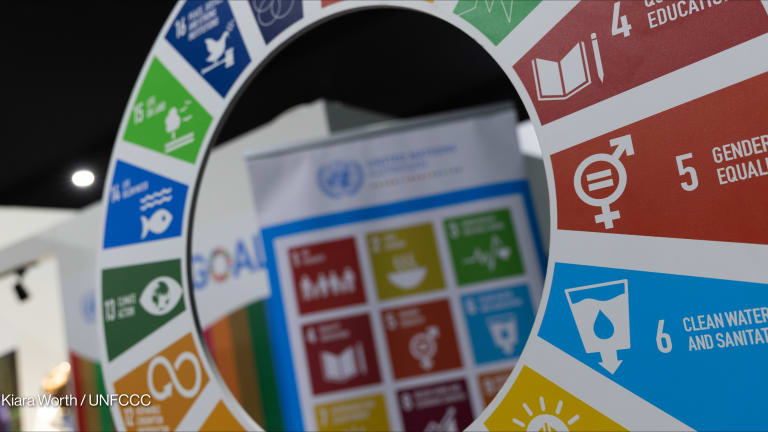How can digital public goods support a better future for health?
The COVID-19 pandemic, and West Africa's Ebola crisis before it, have highlighted the need for digital health tools — whether software, services, or content — that can be used across different contexts.
During the Ebola epidemic in West Africa from 2014 to 2016, countries were inundated with untested digital health solutions, which were developed without standards and did not last. “There was no coordinated global goods approach,” said Dykki Settle, chief digital officer at PATH, an NGO focused on global health innovation. Settle is involved in a range of projects related to digital health and said the field has made a lot of progress over the past five years. “We were so fragmented and so uncoordinated we really almost caused challenges more than we supported them.” That led to the launch of Digital Square, which brings partners together to improve the design, use, and funding of digital health tools and approaches. The goal is to create “a thriving marketplace for digital health.” Now led by PATH, the initiative was initially founded and designed by the U.S. Agency for International Development and the Bill & Melinda Gates Foundation. “What we will need to do as Digital Square … is to support these products to achieve that compliance and work in a coordinated way in order to support country priorities.” --— Dykki Settle, chief digital officer, PATH “The launch of Digital Square was an effort to bring donors together to coinvest, to identify the software global goods countries were already using, and to support them versus continuing this duplicative investment in uncoordinated pilots,” Settle said. Digital Square is committed to supporting digital public goods, which it defines as adaptable digital health tools — whether software, services, or content — that can be used across different contexts. The COVID-19 pandemic has fast-tracked digital health innovation. And the more benefits these tools bring, the more critical it becomes to ensure that all countries benefit. Governments that seek to leverage digital technologies in order to improve the quality, efficiency, and accessibility of health care are often overwhelmed by just how many options there are. They might consider digital public goods, which are already operating at scale in multiple geographies and able to be adapted to other contexts — particularly now that a number of efforts are underway to connect the dots between these disparate technologies. As it stands, many country investments result in “an ad hoc set of digital vertical solutions,” said Garrett Mehl, unit head for the World Health Organization’s department of digital innovation. It is challenging for governments to ensure these digital health solutions can work “as a cohesive whole of foundational tools and services” for a variety of stakeholders, from health workers to patients, he said in a session on digital public goods at this week’s Global Digital Health Forum. Software developers working on technologies intended for low- and middle-income countries can also benefit from “a complementary set of tools and services” that will enable them to test if their digital health solutions work within a particular setting, Mehl added. WHO is increasingly getting involved in digital public goods. For example, its SMART Guidelines, released earlier this year, aim to systematize lifesaving digital health interventions, so they are “Standards-based, Machine-readable, Adaptive, Requirements-based, and Testable.” WHO recently launched a Digital Clearinghouse to provide health systems with the information they need to make informed decisions, including whether a particular technology is effective, able to integrate with existing systems, and scalable. WHO can play a unique role in helping governments navigate the variety of digital health solutions presented to them by vendors, implementers, and donors alike, Settle said in a follow-up interview with Devex. For example, WHO can provide unbiased information on how to select appropriate technologies to support national health systems, he said. Settle also highlighted the value of the work that WHO is doing with Google to develop a Software Development Kit that has the potential to accelerate the development of global goods. “What we will need to do as Digital Square, and as donors and investors, is to support these products to achieve that compliance and work in a coordinated way in order to support country priorities,” he said. Another effort to avoid repeating the mistakes that arose with digital health solutions in the Ebola crisis is the COVID-19 Digital Health Center of Excellence, or DICE, co-led by WHO and UNICEF. The goal is to ensure “we don't end up with COVID-specific solutions working outside the digital health ecosystem,” said Karin Kallander, co-founder of DICE, said on the panel. DICE aims to help countries identify solutions that will support their COVID-19 response, but also strengthen their health systems longer term. Digital public goods could inspire private sector partners to better align with the global health community’s standards, Kallander added. “I don’t think we’ll see everyone go open source,” she said. “But it may inspire vendors who may want to protect their source code but at least make sure they align with best practices when it comes to interoperability, when it comes to the content.”
During the Ebola epidemic in West Africa from 2014 to 2016, countries were inundated with untested digital health solutions, which were developed without standards and did not last.
“There was no coordinated global goods approach,” said Dykki Settle, chief digital officer at PATH, an NGO focused on global health innovation. Settle is involved in a range of projects related to digital health and said the field has made a lot of progress over the past five years. “We were so fragmented and so uncoordinated we really almost caused challenges more than we supported them.”
That led to the launch of Digital Square, which brings partners together to improve the design, use, and funding of digital health tools and approaches. The goal is to create “a thriving marketplace for digital health.” Now led by PATH, the initiative was initially founded and designed by the U.S. Agency for International Development and the Bill & Melinda Gates Foundation.
This story is forDevex Promembers
Unlock this story now with a 15-day free trial of Devex Pro.
With a Devex Pro subscription you'll get access to deeper analysis and exclusive insights from our reporters and analysts.
Start my free trialRequest a group subscription Printing articles to share with others is a breach of our terms and conditions and copyright policy. Please use the sharing options on the left side of the article. Devex Pro members may share up to 10 articles per month using the Pro share tool ( ).
Catherine Cheney is the Senior Editor for Special Coverage at Devex. She leads the editorial vision of Devex’s news events and editorial coverage of key moments on the global development calendar. Catherine joined Devex as a reporter, focusing on technology and innovation in making progress on the Sustainable Development Goals. Prior to joining Devex, Catherine earned her bachelor’s and master’s degrees from Yale University, and worked as a web producer for POLITICO, a reporter for World Politics Review, and special projects editor at NationSwell. She has reported domestically and internationally for outlets including The Atlantic and the Washington Post. Catherine also works for the Solutions Journalism Network, a non profit organization that supports journalists and news organizations to report on responses to problems.








